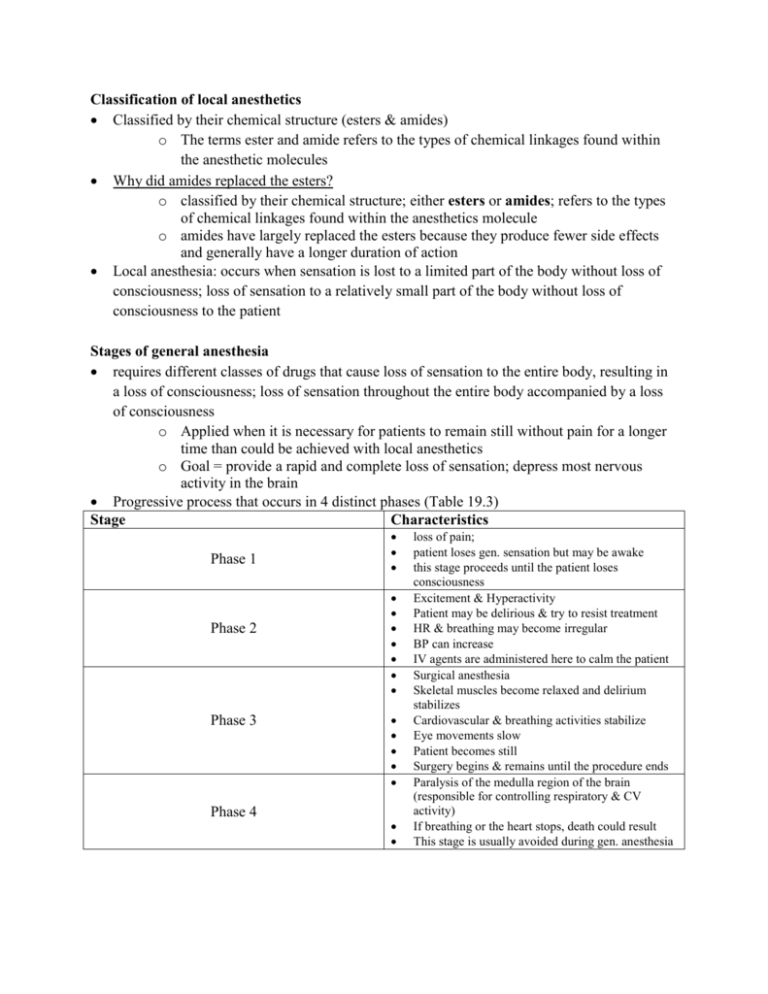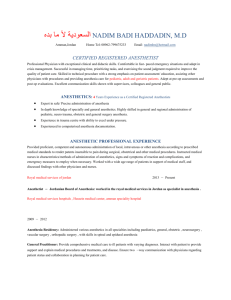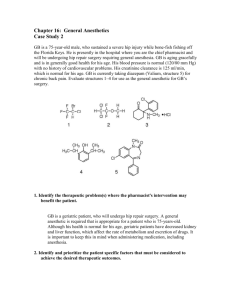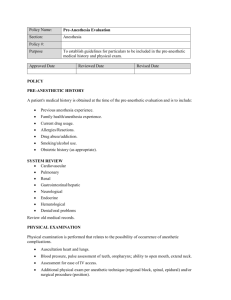Classification of local anesthetics
advertisement

Classification of local anesthetics Classified by their chemical structure (esters & amides) o The terms ester and amide refers to the types of chemical linkages found within the anesthetic molecules Why did amides replaced the esters? o classified by their chemical structure; either esters or amides; refers to the types of chemical linkages found within the anesthetics molecule o amides have largely replaced the esters because they produce fewer side effects and generally have a longer duration of action Local anesthesia: occurs when sensation is lost to a limited part of the body without loss of consciousness; loss of sensation to a relatively small part of the body without loss of consciousness to the patient Stages of general anesthesia requires different classes of drugs that cause loss of sensation to the entire body, resulting in a loss of consciousness; loss of sensation throughout the entire body accompanied by a loss of consciousness o Applied when it is necessary for patients to remain still without pain for a longer time than could be achieved with local anesthetics o Goal = provide a rapid and complete loss of sensation; depress most nervous activity in the brain Progressive process that occurs in 4 distinct phases (Table 19.3) Stage Characteristics Phase 1 Phase 2 Phase 3 Phase 4 loss of pain; patient loses gen. sensation but may be awake this stage proceeds until the patient loses consciousness Excitement & Hyperactivity Patient may be delirious & try to resist treatment HR & breathing may become irregular BP can increase IV agents are administered here to calm the patient Surgical anesthesia Skeletal muscles become relaxed and delirium stabilizes Cardiovascular & breathing activities stabilize Eye movements slow Patient becomes still Surgery begins & remains until the procedure ends Paralysis of the medulla region of the brain (responsible for controlling respiratory & CV activity) If breathing or the heart stops, death could result This stage is usually avoided during gen. anesthesia Topical Anesthetics Formulation/Method - Creams, sprays, suppositories, drops, & lozenges Description - Applied to mucous membranes including the eyes, lips, gums, nasal membranes, and throat; very safe unless absorbed Table 19.4 Inhaled General Anesthetics Gas (nitrous oxide) - Adverse Effects o Malignant hyperthermia o Apnea o Cyanosis Table 19.6 Selected Adjuncts to Anesthesia Neuromuscular blocker - Succinylcholine (Adverse effect) o Respiratory depression o Apnea o Malignant hyperthermia o Circulatory collapse Prototype drug Succinylcholine Action and Uses – acts on cholinergic receptor sites at neuromuscular junction o 1st depolarization occurs & skeletal muscle contracts o After repeated contractions, the membrane is unable to repolarize as long as the drug stays attached to the receptor o Effects are 1st noted as muscle weakness & muscle spasms o Eventually paralysis occurs o This drug is rapidly broken down by cholinesterase o When infusion is stopped, the duration of action is only a few minutes o Use of this drug reduces the amount of general anesthesia required for a procedure o Dantrium is a drug used preoperatively/postoperatively to reduce the signs of malignant hyperthermia in susceptible patients Mechanism of action of local anesthetics Local anesthetics = drugs that produce a rapid loss of sensation to a limited part of the body by blocking entry of sodium ions into the neurons o [Na+] is higher outside the neurons than inside; a rapid influx of [Na+] into the cell is necessary for neurons to fire o Local anesthetics act by blocking Na+ channels o blocking Na+ channels is a nonselective process so both sensory and motor impulses are affected o so both sensation and muscle activity will temporarily diminish in the area treated with the local anesthetic also called sodium channel blockers because of the mechanism of action What is the rationale of adding epinephrine? o Small amounts of epinephrine are sometimes added to the anesthetic solution to constrict blood vessels in the immediate area where the local anesthetic is applied o This keeps the anesthetic in the area longer, thus extending the duration of action of the drug Inhaled anesthetics (Nursing Implications) Inhaled agents are used to maintain the anesthesia Should be used cautiously in patients with myasthenia gravis o It may cause respiratory depression and prolonged hypnotic effects Patients with cardiovascular disease, especially those with increase intracranial pressure, should be carefully monitored o Hypnotic effects of the drug may be prolonged or potentiated Always assess for past history of surgeries and response to anesthesia Asses past history, allergies and medications Assess use of alcohol, illicit drugs, and opioids Assessment is vital during pre-, intra-, and postoperative phases o Vitals, baseline lab work, ECG, pulse oximeter, ABCs (airway, breathing, circulation, monitor all body systems) Reorient patient to his or her surroundings Provide preoperative teaching about the surgical procedure and anesthesia Teach the patient about postoperative turning, coughing, & deep breathing Adverse Effects of Local anesthetics CNS stimulation (restlessness or anxiety) Drowsiness Unresponsiveness Hypotension dysrhythmias Inhaled anesthetics the only gas used routinely for anesthesia is nitrous oxide, commonly called laughing gas o used for dental procedures & brief obstetric and surgical procedures o also used in conjunction with other general anesthetics making it possible to decrease their dosages with greater effectiveness What is the rationale for the use of IV before Gas anesthetics? o Concurrent administration of IV and inhaled anesthetics allows the dose of the inhaled agent to be reduced, thus lowering the potential for serious side effects o When IV & inhaled anesthetics are combined, they provide greater analgesia and muscle relaxation than can be provided by the inhaled anesthetic alone Spinal anesthesia Formulation/Method - Injection into the cerebral spinal fluid (CSF) Description - Drug affects a large, regional area such as the lower abdomen & legs Postoperative Care? Priority Nursing Interventions? Local Anesthetics: drugs that produce a rapid loss of sensation to a limited part of the body by blocking entry of sodium ions into the neurons occurs when sensation is lost to a limited part of the body without loss of consciousness; loss of sensation to a relatively small part of the body without loss of consciousness to the patient Table 19.1 Methods of local anesthetics administration Route Formulation/Method Epidural anesthesia Infiltration (field block) anesthesia Nerve block Anesthesia Spinal Anesthesia Topical (surface) anesthesia Description Injection into the epidural space of the spinal cord Most commonly used in obstetrics during labor & delivery Direct injection into tissue Drug diffuses into tissue to block immediate to the surgical site a specific group of nerves in a small area close to the surgical site Direct injection into tissue that Drug affects nerve bundles may be distant from the operation serving the surgical area; used to site block sensation in a limb or large area of the face Injection into the cerebral spinal Drug affects a large, regional fluid (CSF) area such as the lower abdomen & legs Creams, sprays, suppositories, Applied to mucous membranes drops, & lozenges including the eyes, lips, gums, nasal membranes, and throat; very safe unless absorbed Neuromuscular blocker agent drug used to cause total muscle relaxation; cause skeletal muscles to totally relax in order to carry out surgical procedures safely administration of these drugs also allows the amount of anesthetic to be reduced Classified as depolarizing blockers (succinylcholine) and nondepolarizing blockers (Mivacurium) o Succinylcholine – works by binding to acetylcholine receptors at neuromuscular junctions to cause total skeletal muscle relaxation; Also used in surgery for ease of tracheal intubation o Mivacurium – short acting; cause muscle paralysis by competing with acetylcholine for cholinergic receptors at neuromuscular junctions; once attached to the receptor, the nonpolarizing blockers prevent muscle contraction Table 19.4 Inhaled General Anesthetics Volatile Liquid – Halothane (Fluothane) o Myocardial depression o Hypotension o Pulmonary vasoconstriction o hepatotoxicity Prototype drug Nitrous oxide Treatment of overdose – metoclopramide may help reduce the symptoms of nausea & vomiting associated with inhalation Table 19.5 Intravenous Anesthetics (Adverse Effects) Propofol (Barbiturate/Barbiturate-like) o Circulatory dep. w/ apnea o Respiratory dep. w/ apnea Midazolam hydrochloride (benzodiazepine) o CNS depression Ketamine (miscellaneous) o Dissociation o Increased BP o Increased pulse rate o Laryngospasm o anaphylaxis o Confusion o Excitement








